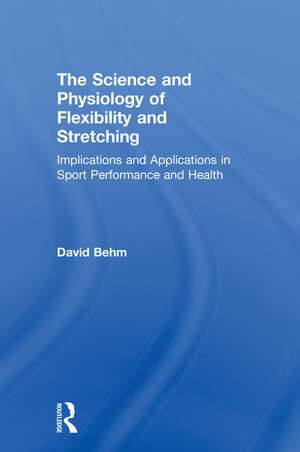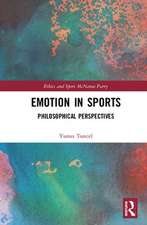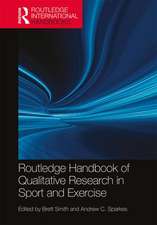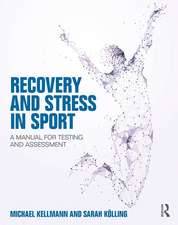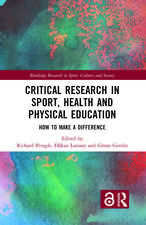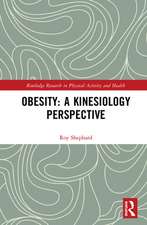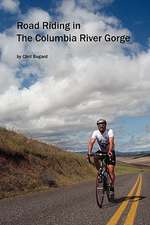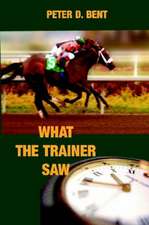The Science and Physiology of Flexibility and Stretching: Implications and Applications in Sport Performance and Health
Autor David Behmen Limba Engleză Hardback – 7 noi 2018
Placing stretching in the context of both health and performance, the first section of the book sets out the science behind stretching, critically assessing the benefits, disadvantages, and roles of different types of stretching, exploring the mechanisms behind increasing range-of-movement through stretching and other methods, and offering evidence-based guidance on building stretching into warm-ups. In its second section, the book provides a step-by-step guide to static, dynamic, and PRF stretching exercises for beginners, through recreational athletes, to elite performers.
Richly illustrated, and including an online resource, The Science and Physiology of Flexibility and Stretching provides an important scientific enquiry into stretching, and an invaluable reference for any strength and conditioning coach or student, personal trainer, sports coach, or exercise scientist.
| Toate formatele și edițiile | Preț | Express |
|---|---|---|
| Paperback (2) | 280.67 lei 3-5 săpt. | +20.42 lei 7-13 zile |
| Taylor & Francis – 30 oct 2024 | 280.67 lei 3-5 săpt. | +20.42 lei 7-13 zile |
| Taylor & Francis – 9 noi 2018 | 348.55 lei 3-5 săpt. | |
| Hardback (2) | 1004.24 lei 6-8 săpt. | |
| Taylor & Francis – 7 noi 2018 | 1159.61 lei 3-5 săpt. | |
| Taylor & Francis – 30 oct 2024 | 1004.24 lei 6-8 săpt. |
Preț: 1159.61 lei
Preț vechi: 1220.65 lei
-5% Nou
Puncte Express: 1739
Preț estimativ în valută:
221.90€ • 237.28$ • 185.01£
221.90€ • 237.28$ • 185.01£
Carte disponibilă
Livrare economică 27 martie-10 aprilie
Preluare comenzi: 021 569.72.76
Specificații
ISBN-13: 9781138086906
ISBN-10: 1138086908
Pagini: 210
Ilustrații: 1 Line drawings, black and white; 7 Tables, black and white; 102 Illustrations, black and white
Dimensiuni: 156 x 234 x 17 mm
Greutate: 0.47 kg
Ediția:1
Editura: Taylor & Francis
Colecția Routledge
Locul publicării:Oxford, United Kingdom
ISBN-10: 1138086908
Pagini: 210
Ilustrații: 1 Line drawings, black and white; 7 Tables, black and white; 102 Illustrations, black and white
Dimensiuni: 156 x 234 x 17 mm
Greutate: 0.47 kg
Ediția:1
Editura: Taylor & Francis
Colecția Routledge
Locul publicării:Oxford, United Kingdom
Public țintă
General, Postgraduate, and UndergraduateCuprins
1. My Personal Motivation for Stretching
2. History of Stretching
3. Types of Stretching and the Effects on Flexibility
4. Mechanisms Underlying Acute Changes in Range of Motion
5. Training-Related Range of Motion Changes and Mechanisms
6. Recommendations for Stretching Prescription
7. Stretching Effects on Injury Reduction and Health
8. Does Stretching Affect Performance?
9. Effect of Stretch Training on Performance
10. Other Flexibility Enhancing Techniques
11. Stretching Exercise Illustrations
2. History of Stretching
3. Types of Stretching and the Effects on Flexibility
4. Mechanisms Underlying Acute Changes in Range of Motion
5. Training-Related Range of Motion Changes and Mechanisms
6. Recommendations for Stretching Prescription
7. Stretching Effects on Injury Reduction and Health
8. Does Stretching Affect Performance?
9. Effect of Stretch Training on Performance
10. Other Flexibility Enhancing Techniques
11. Stretching Exercise Illustrations
Notă biografică
David G. Behm, PhD, is a University Research Professor at the School of Human Kinetics and Recreation, Memorial University of Newfoundland, Canada. He was a highly competitive athlete, was drafted into the Canadian Football League (1979) and won Canadian provincial championships in tennis (Saskatchewan: 1987) and squash (Newfoundland: 2000, 2002). His athletic background led him to an academic career in the areas of applied neuromuscular physiology and sport/exercise science. Dr. Behm has won a number of university, national, and international awards. He has published over 230 peer-reviewed scientific articles with over 14,000 citations. He consistently presents his research findings internationally and his work is often featured in popular fitness and health magazines, and online publications.
Descriere
The Science and Physiology of Flexibility and Stretching is the most up-to-date and comprehensive book to cover the underlying physiology and psychology of stretching, critically assessing why, when and how we should stretch, as well as offering a highly illustrated, practical guide to stretching exercises. Placing stretching in the context of both health and performance, the first section of the book sets out the science behind stretching, critically assessing the benefits, disadvantages and roles of different types of stretching, exploring the mechanisms behind increasing range-of-movement through stretching and other methods, and offering evidence-based guidance on building stretching into warm-ups. In its second section, the book provides a step-by-step guide to static, dynamic and PRF stretching exercises for beginners, through recreational athletes, to elite performers.
Recenzii
"In this comprehensive textbook, readers will discover a wealth of stretching techniques designed to improve flexibility, sport performance, prevent injuries, and promote overall health. Whether you are an athlete looking to enhance performance or simply aiming to increase your range of motion, Professor Behm’s textbook is a must-have addition to your fitness library."
Prof. Urs Granacher, PhD, University of Freiburg, Germany.
"Professor Behm shares his profound knowledge and expertise in this book. The body of available evidence is presented using an explicative and practical narrative. An essential read for all those interested in the topic."
Prof. Rodrigo Ramirez-Campillo PhD, Exercise and Rehabilitation Sciences Institute. School of Physical Therapy. Faculty of Rehabilitation Sciences. Universidad Andres Bello. Santiago, Chile.
"It is the perfect book to tap into the wisdom of stretching as developed by researchers. By reading this book, you will gain wisdom about the past, present, and imagine the future of stretching"
Prof. Masatoshi Nakamura PhD,Faculty of Rehabilitation Sciences, Nishi Kyushu University, Kanzaki, Saga, Japan
"With this work, Prof. Behm provides an encyclopedia of flexibility techniques that illustrates the current scientific knowledge on stretching and related training techniques in the most comprehensive manner. The content of this book served as an important baseline for much ongoing research, including my PhD Thesis."
Konstantin Warneke PhD, University of Graz, Graz Austria
Prof. Urs Granacher, PhD, University of Freiburg, Germany.
"Professor Behm shares his profound knowledge and expertise in this book. The body of available evidence is presented using an explicative and practical narrative. An essential read for all those interested in the topic."
Prof. Rodrigo Ramirez-Campillo PhD, Exercise and Rehabilitation Sciences Institute. School of Physical Therapy. Faculty of Rehabilitation Sciences. Universidad Andres Bello. Santiago, Chile.
"It is the perfect book to tap into the wisdom of stretching as developed by researchers. By reading this book, you will gain wisdom about the past, present, and imagine the future of stretching"
Prof. Masatoshi Nakamura PhD,Faculty of Rehabilitation Sciences, Nishi Kyushu University, Kanzaki, Saga, Japan
"With this work, Prof. Behm provides an encyclopedia of flexibility techniques that illustrates the current scientific knowledge on stretching and related training techniques in the most comprehensive manner. The content of this book served as an important baseline for much ongoing research, including my PhD Thesis."
Konstantin Warneke PhD, University of Graz, Graz Austria
